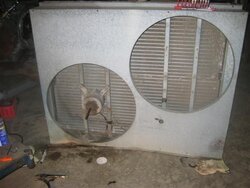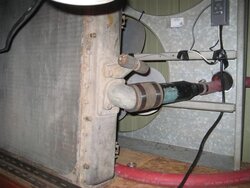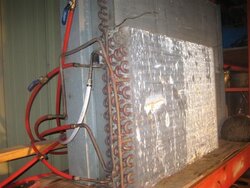Will it work to use an old airconditioner for a shop heater and also double as overheat protection. I have three 25 plus year old airconditioners ( the big 110v). It would be a raidiator with a fan to push air. Is it possible for one or both?
What about using an old air conditioner for heater and overheat loop.
- Thread starter Rugar
- Start date
-
Active since 1995, Hearth.com is THE place on the internet for free information and advice about wood stoves, pellet stoves and other energy saving equipment.
We strive to provide opinions, articles, discussions and history related to Hearth Products and in a more general sense, energy issues.
We promote the EFFICIENT, RESPONSIBLE, CLEAN and SAFE use of all fuels, whether renewable or fossil.
You are using an out of date browser. It may not display this or other websites correctly.
You should upgrade or use an alternative browser.
You should upgrade or use an alternative browser.
- Status
- Not open for further replies.
Fred61
Minister of Fire
I took advantage of an existing Modine unit in my basement for my overheat loop, to expedite my installation last fall but I plan on changing it this coming summer. The problem is that you are having to run both the circulator motor AND the fan motor. In case of a power failure, I want the lowest possible power draw in order to run the overheat loop with an inverter. I don't plan on running my EKO during power failures as I have other means for heating but I need to have a place for the heat to go if the power drops out with a full load of fuel. I'm in the process of building my unpressurized storage tank and plan on putting a copper coil which I had laying around from another project, in the bottom of the tank.
jebatty
Minister of Fire
AC condenser tubes (to be hot water tubes) usually are pretty small, less than 1/2" I think (although I don't have an AC so check yours), and circulating water through them likely is to face considerable pump head and may not be effective. 1/2" is only rated at 1.5 gpm, 15000 btuh at delta-T of 20. 20' of 0.25 ID tubing, 0.5 gpm has a pump head of almost 7', and at delta-T=20 btuh would be 5000, not enough for an overheat loop for most gasifiers/wood boilers.
Ugly
New Member
Rugar said:Will it work to use an old airconditioner for a shop heater and also double as overheat protection. I have three 25 plus year old airconditioners ( the big 110v). It would be a raidiator with a fan to push air. Is it possible for one or both?
I use the rear heater from a large bus. Already runs on 12volts and will act as a pretty fair water to air exchanger in the event of overheat. Easy to find these anyplace they have a school bus in a scrap yard. We draw directly from one of the incoming lines (non pressurised at this point) and use the water pump out of a commercial dishwasher on a motor controller (mine is something I made, but for small pumps a light dimmer switch rated for 6 amps or a router motor controller also works) to control velocity. It's non emergency job is to the heat the changing shack where the kids put their skates on.
For those on a municipal water supply, a good overheat protection system might be valving one of the existing brazed plate exchangers (say the one used for the hot water tank) in a such a way as to bring in fresh cold municipal water and be able to dump the heated fluid down the drain...
Just some ideas.
Regards,
Ugly
Paso
Member
I have done this with mixed sucess. If the air conditioner exchanger is in a heated area already it will work just fine. In my case the fans were so strong that on a very cold day in a un heated shop the fans sucking cold air and the tubes being so small I literly froze the water in the lines.
It did puke out a lot of heat when using it. I have since cut the unit in half and use only one fan behind a big detroit deisel bus rad.
It did puke out a lot of heat when using it. I have since cut the unit in half and use only one fan behind a big detroit deisel bus rad.
Attachments
Paso
Member
Fred61 said:I took advantage of an existing Modine unit in my basement for my overheat loop, to expedite my installation last fall but I plan on changing it this coming summer. The problem is that you are having to run both the circulator motor AND the fan motor. In case of a power failure, I want the lowest possible power draw in order to run the overheat loop with an inverter. I don't plan on running my EKO during power failures as I have other means for heating but I need to have a place for the heat to go if the power drops out with a full load of fuel. I'm in the process of building my unpressurized storage tank and plan on putting a copper coil which I had laying around from another project, in the bottom of the tank.
No to dissuade you from building a better heat sink but to help prevent overheat with a full load and a power outage (as long as you are there so you can do something about it) try closing your secondary air supply completely off as this will (should any how if your secondaries seal well) close off the air supply to the fuel and if not extinguish the fire it should choke it's ability to run away. Another secondary precaution is to also close the shutter on your fan housing though the position of your primary air inlets will determine if this would really help or not.
Fred61
Minister of Fire
Cave2k said:Fred61 said:I took advantage of an existing Modine unit in my basement for my overheat loop, to expedite my installation last fall but I plan on changing it this coming summer. The problem is that you are having to run both the circulator motor AND the fan motor. In case of a power failure, I want the lowest possible power draw in order to run the overheat loop with an inverter. I don't plan on running my EKO during power failures as I have other means for heating but I need to have a place for the heat to go if the power drops out with a full load of fuel. I'm in the process of building my unpressurized storage tank and plan on putting a copper coil which I had laying around from another project, in the bottom of the tank.
No to dissuade you from building a better heat sink but to help prevent overheat with a full load and a power outage (as long as you are there so you can do something about it) try closing your secondary air supply completely off as this will (should any how if your secondaries seal well) close off the air supply to the fuel and if not extinguish the fire it should choke it's ability to run away. Another secondary precaution is to also close the shutter on your fan housing though the position of your primary air inlets will determine if this would really help or not.
The key words are "as long as you are there." In fact I've had some sleep interruptions this winter worrying about power loss during some ice storms since I just hooked up my boiler this fall and don't have an inverter hooked up yet. If I am home and awake, I can also fire up a generator. Having had a Wood Gun, which had a motor driven air intake and no secondary air that would actually extinguish the fire if it idled for any length of time, I was thinking there must be something wrong with the EKO at first. I fiddled with the air flap at the fan output add sealed around the fan panel which helped. My question is, If I can stop the flow by shutting the fan shutter and secondary why doesn't the air flap stop the air from getting into the primary and secondary chamber? Does the draft overcome the counterweight on the air flap?
Ugly
New Member
Fred;
a thought
The draft fan on my boiler has a cover with gasket on it's intake... when the aquastat relay turns on the blower, power is supplied to the electromagnet and pulls the cover off the blower intake, when power is off (or fails) it automatically chokes all incoming air.
a thought
The draft fan on my boiler has a cover with gasket on it's intake... when the aquastat relay turns on the blower, power is supplied to the electromagnet and pulls the cover off the blower intake, when power is off (or fails) it automatically chokes all incoming air.
Fred61
Minister of Fire
Ugly said:Fred;
a thought
The draft fan on my boiler has a cover with gasket on it's intake... when the aquastat relay turns on the blower, power is supplied to the electromagnet and pulls the cover off the blower intake, when power is off (or fails) it automatically chokes all incoming air.
That's something I could play with. I suppose I could scavenge the coil from an old relay an easily try it. Since the inverter powered overheat loop and larger storage are in the plan, the continual air supply to the fire is not as big an issue to to me at this point and I have learned to live with it for normal operation, but of course the power failure problem still exists. Your suggestion is a much easier fix than the one I had been sleeping on. I was thinking about finding a way to motorize (is that a word?) the flap.
- Status
- Not open for further replies.
Similar threads
- Replies
- 1
- Views
- 375
- Replies
- 1
- Views
- 842
- Replies
- 36
- Views
- 5K
- Replies
- 2
- Views
- 1K




